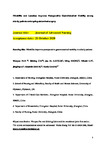External Use of Mirabilite Combined with Lactulose Improves Postoperative Gastrointestinal Mobility among Older Patients Undergoing Abdominal Surgery
| dc.contributor.author | Pan, W | |
| dc.contributor.author | Cai, S | |
| dc.contributor.author | Latour, Jos M | |
| dc.contributor.author | Zhong, M | |
| dc.contributor.author | Lv, M | |
| dc.contributor.author | Li, J | |
| dc.contributor.author | Zhang, X | |
| dc.contributor.author | Zhang, Y | |
| dc.date.accessioned | 2020-11-03T14:18:42Z | |
| dc.date.issued | 2020-11-24 | |
| dc.identifier.issn | 0309-2402 | |
| dc.identifier.issn | 1365-2648 | |
| dc.identifier.uri | http://hdl.handle.net/10026.1/16627 | |
| dc.description.abstract |
<jats:title>Abstract</jats:title><jats:sec><jats:title>Aims</jats:title><jats:p>To evaluate the feasibility and efficacy of Mirabilite combined with Lactulose in older patients after abdominal surgery.</jats:p></jats:sec><jats:sec><jats:title>Design</jats:title><jats:p>It is a retrospective observational cohort study with a pre and post intervention group.</jats:p></jats:sec><jats:sec><jats:title>Methods</jats:title><jats:p>Medical records were retrospectively reviewed of postoperative Intensive Care patients with postoperative gastrointestinal tract dysfunction (aged >60 years) in the Surgical Intensive Care Unit from January 2017–December 2018.</jats:p></jats:sec><jats:sec><jats:title>Results</jats:title><jats:p>One hundred and sixty‐seven post‐surgical Intensive Care patients with postoperative gastrointestinal tract dysfunction were analysed; 74 patients received Mirabilite + Lactulose treatment and 93 patients received Lactulose treatment. The recovery rate of bowel sounds was better in the Mirabilite + Lactulose group (62.16%) compared with the Lactulose group (37.63%) after 3‐day treatment (<jats:italic>p</jats:italic> = 0.002) and the relative risk (RR) was 1.65 (95% CI, 1.20, 2.27). Moreover 70.27% patients in the Mirabilite + Lactulose group finally had flatus or defecation compared with 46.24% patients in Lactulose group (<jats:italic>p</jats:italic> = 0.003) and the RR was 1.52 (1.17, 1.98). The abdominal girth and Inter Abdominal Pressure in Mirabilite + Lactulose group showed significantly greater decrease over a 3‐day period compared with Lactulose group (4.86 vs. 3.46 cm, <jats:italic>p</jats:italic> = 0.027; 4.80 vs. 3.11 mmHg, <jats:italic>p</jats:italic> = 0.002 respectively). The pain score had greater decrease from the baseline in Mirabilite + Lactulose group than in Lactulose group (2.40 vs. 1.11; <jats:italic>p</jats:italic> < 0.01). Patients in the Mirabilite + Lactulose group had shorter hospital stay than the Lactulose group 12.5 (<jats:italic>SD</jats:italic> 3.51) versus 13.9 (<jats:italic>SD</jats:italic> 5.14), <jats:italic>p</jats:italic> = 0.05.</jats:p></jats:sec><jats:sec><jats:title>Conclusions</jats:title><jats:p>This study demonstrated that external use of Mirabilite combined with Lactulose can be considered as an easy intervention to improve postoperative gastrointestinal mobility in older intensive care patients who suffer from postoperative gastrointestinal tract dysfunction after surgery.</jats:p></jats:sec><jats:sec><jats:title>Impact</jats:title><jats:p>Our results provide a great option to alleviate the sufferings of postoperative patients. The externally use Mirabilite is a painless and safe interventions that is easy to implement by ICU nurses.</jats:p></jats:sec> | |
| dc.format.extent | 755-762 | |
| dc.format.medium | Print-Electronic | |
| dc.language | en | |
| dc.language.iso | en | |
| dc.publisher | Wiley | |
| dc.subject | intensive care | |
| dc.subject | intra‐ | |
| dc.subject | abdominal surgery | |
| dc.subject | Mirabilite | |
| dc.subject | nursing | |
| dc.subject | postoperative gastrointestinal mobility | |
| dc.title | External Use of Mirabilite Combined with Lactulose Improves Postoperative Gastrointestinal Mobility among Older Patients Undergoing Abdominal Surgery | |
| dc.type | journal-article | |
| dc.type | Journal Article | |
| dc.type | Observational Study | |
| plymouth.author-url | https://www.webofscience.com/api/gateway?GWVersion=2&SrcApp=PARTNER_APP&SrcAuth=LinksAMR&KeyUT=WOS:000591663400001&DestLinkType=FullRecord&DestApp=ALL_WOS&UsrCustomerID=11bb513d99f797142bcfeffcc58ea008 | |
| plymouth.issue | 2 | |
| plymouth.volume | 77 | |
| plymouth.publication-status | Published | |
| plymouth.journal | Journal of Advanced Nursing | |
| dc.identifier.doi | 10.1111/jan.14640 | |
| plymouth.organisational-group | /Plymouth | |
| plymouth.organisational-group | /Plymouth/Faculty of Health | |
| plymouth.organisational-group | /Plymouth/Faculty of Health/School of Nursing and Midwifery | |
| plymouth.organisational-group | /Plymouth/REF 2021 Researchers by UoA | |
| plymouth.organisational-group | /Plymouth/REF 2021 Researchers by UoA/UoA03 Allied Health Professions, Dentistry, Nursing and Pharmacy | |
| plymouth.organisational-group | /Plymouth/Research Groups | |
| plymouth.organisational-group | /Plymouth/Research Groups/Institute of Health and Community | |
| plymouth.organisational-group | /Plymouth/Research Groups/Plymouth Institute of Health and Care Research (PIHR) | |
| plymouth.organisational-group | /Plymouth/Users by role | |
| plymouth.organisational-group | /Plymouth/Users by role/Academics | |
| dc.publisher.place | England | |
| dcterms.dateAccepted | 2020-10-21 | |
| dc.rights.embargodate | 2021-11-24 | |
| dc.identifier.eissn | 1365-2648 | |
| dc.rights.embargoperiod | Not known | |
| rioxxterms.versionofrecord | 10.1111/jan.14640 | |
| rioxxterms.licenseref.uri | http://www.rioxx.net/licenses/all-rights-reserved | |
| rioxxterms.licenseref.startdate | 2020-11-24 | |
| rioxxterms.type | Journal Article/Review |


